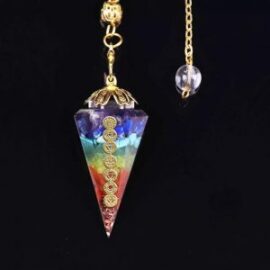When we use the pendulum, or any tools for divination: Tarot, I Ching, Runes…. we aren’t doing anything out of the ordinary. We are simply using the sixth sense we were born with.
Natural intuition is a feeling that guides us in a certain direction without fully understanding why. It is something that we know or understand without proof or evidence.
In using a pendulum, we are using our natural intuition to speak to us through a device that will give us answers we can understand. The pendulum helps us takes the guesswork out of inner guidance.
Opening to our intuitive nature is really about paying attention, listening and being present in the moment, fully open in our minds and bodies to hearing guidance. It is also about trust. When we trust ourselves, and the answers we are receiving, we connect to the greater voice within. When we listen to that voice deeply we receive the guidance we seek.
Pendulums are extensions of our subconscious. To use them we only have to be open and listen to what they have to tell us. Holding the pendulum is the easy part; listening is the greater challenge.
David Hawkins says in Power Vs Force, “We have at our fingertips a means of accurately distinguishing truth from falsehood, workable from unworkable, benevolent from malign. We can illuminate the hidden forces, hitherto overlooked, that determine human behavior, We have at our disposal a means of finding answers to previously unresolved personal and social problems. Falsehood need no longer hold sway over our lives.” P. 13
This is the first step in the healing process.
How to use a pendulum. 10 easy steps
Preparation: there are a few things you’ll want to do, first.
- If your pendulum is made of crystal or gemstone, cleanse it before you begin the session. (see cleansing instructions at the end of the chapter)
- Position the pendulum in your hand. Arch your wrist over a tabletop or chart. Make sure your elbow or forearm is comfortable if you are using a table. Grasp the chain or string between your thumb and forefinger. Hold it at least 3-4” from the pendulum so it can swing freely to and fro.
- It is important to relax and breathe. Calm your mind so the subconscious can communicate with you via idiomatic movements. A common explanation is to Tune In to your inner self, breathe, relax and allow the interaction between mind and body to engage.
- Ask the pendulum to show you a “YES” direction and movement. Take your time.
- Ask the pendulum to show you a “NO” direction and movement, Take your time. These may be clockwise and counterclockwise circles. Once you have established the yes and no directions of this session begin asking questions.
- Test these signals by asking for a few easy answers, like, “Is today Sunday?” or “Is the name of my dog Wendy?” “Do Pigs fly?” A clockwise swing “YES” for you might mean the opposite answer in someone else’s hand. It’s essential to check and verify the direction of the answers from the pendulum.
- Phrase your questions to the pendulum so it can give you answers as a “YES” or a “NO”. Like, “Is this a good time to sell my house?” “Should I ask for a promotion at work?” “Do I need to eat more vegetables?” “Should I buy a new car now?” Make sure the question is easy for the pendulum to understand and answer with a yes or no answer. You can always use follow up questions like, “Should I buy a green car?” “Should I buy a yellow car?”
- Don’t expect the pendulum to give you the name of your soulmate unless you are willing to spend the next year running names by it.
- Perform a Final Call with the pendulum to see if the session is complete. Ask the question: “Is there anything more you wish to communicate?” If the answer is “YES” then you need to keep asking questions that can be answered for you that will bring even more clarity to the situation.
- You always sign off with a “thank you” to the pendulum, your two minds and all of the invisible forces that combined to show up for this session. This is the time to express gratitude for the help you received. The more gratitude you express, the better your next session will be. (True!)

Pendulum Etiquette
Once you know how to work your pendulum and you have become sufficient in the manual dexterity of pendulum motion you can move onto a higher level of communication and complexity. I like to call it Pendulum Etiquette.
Pendulum etiquette is where you say please, ask permission and interact with your pendulum and the forces that are giving you the answers. Respect never hurts when working with the unseen elements.
Here are the key phrases you want to use when seeking information.
Do I have your permission to proceed?
Am I allowed to dowse in this area? (Meaning either locale or subject matter.)
Is this a suitable subject to pursue?
Allow the pendulum to inform you. If the pendulum replies “NO” to any of these question, pursue it further. For example.
Do I have your permission to proceed? “NO” Next question should be:
Is there something else I need to know before proceeding? “YES”
Is there someone I need to contact before proceeding? “NO”
Is there danger in proceeding? “YES” Okay, you’ve just received a warning. You can continue asking questions, or you can cease the session. You might want to ask who is in danger or for more specifics. Just be sure to heed the basic caution as you delve deeper.
If you had received a “YES” and then gotten a “NO” on the next question, Am I allowed to dowse in this area? You might want to ask questions about legality, safety, ownership, location, and so on. If you get a “NO” on the question, Is this a suitable subject to pursue? You may want to ask further queries to determine the why. Perhaps you could ask, “Will someone or something be damaged if I pursue this subject? Are we in danger if we move forward? Is this a line of inquiry that is legally protected? Is this none of my business? Will getting this information harm someone? “ The questions will get you to the truth of why you should not proceed.
If you got green lights in the answers to your questions, then you are in excellent shape to proceed.
How to Ask Questions
You need to be very specific in the questions you ask and what you want to know. This is especially true in the what, where and when aspects of your question.
- Use only words, phrases and conditions that you and the pendulum have mutually agreed what the meaning is and you have established a specific pendular response pattern for answers.
- Never ask for an opinion. Always ask a question for which there is an answer out there somewhere.
Examples of Questions
The types of questions you want to ask in Level One are questions about everyday things like people, choices, events, health, wealth and happiness. Here are some examples.
Will I get the job at Disneyland?
Is this current relationship good for me?
Should I take the job offered at Rocky’s Pizza?
Will I ever write a book?
Should I buy the house on Johnson Street?
Is Dr. Watson the best doctor for me?
Should I say “YES” to Gus? Should I say “NO” to Gus?
Will there be someone better for me than Beau?
Should I see a doctor about my ________?
Will going to Europe make me happy?
Should I go back to school?
Should I change my major?
Should I have a child now?
Is Henry being honest with me?
Do I need to report Sally to HR for misconduct?
Should I hire William S.?
Do I need to know more about William S. before I hire him?
Remember: your answers are only as good as your questions.
If you aren’t succeeding as you wish to, there could be 5 reasons why:
- You’re not asking your questions clearly enough.
- Was your question too short?
- Was your question too vague?
- You were not tuned in and in the appropriate receptive and connected state.
- You may not have defined your communication terms with the pendulum clearly.
- You did not have a clear enough goal in mind.
- You were emotionally attached to getting a certain answer.
Working with a pendulum is a lot of fun. It’s exciting when you watch it perform and give you answers to your questions. As you become more secure and proficient with your ability to work with the pendulum, you can teach others to use it or answer their questions. The main key is connection. Connection with the pendulum, the process and the questions. Connection with yourself. It’s a beautiful way to delve into the questions of life and provide your own answers from the depth of wisdom you have within. Without the help of the pendulum you might have never uncovered this information.


